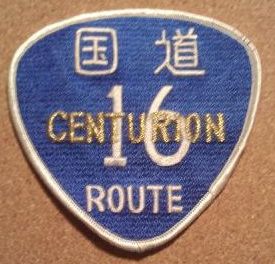03 March 2010
Kanto Quadralateral

I still have my Route 16 Centurion patch- one of the most elegant ever embroidered by the crafty Nipponese in the Honcho-ku outside the main gate at the Yokosuka Naval Base. You could have patches made a lot of places in the Far East back then. Korea was cheap, the P.I. cheaper still, but there were the lands of the not-quite0right.
The Japanese did a quality job. I just looked at the patch this morning, on my way to look for something else. Suddenly, much later in the day, I recollected where the other patch is located- in a bag of Midway memorabilia I have been meaning to donate to the CV-41 Museum people.
That is enough to give one pause, looking at your crap to donate to museums. Where did the time go? What on earth was I thinking?
I touched the blue field with the Kanji characters, faithfully reproduced from he road signs that identified the road from Yoko up through Yokohama to the madness of Tokyo. Superimposed was the English word “Centurion,” which on the purely military patches commemorated the completion of one hundred arrested landings on the boat.
Only the pilots and the Naval flight Officers could really qualify for that, but we all had cars, of course, worked on the cheap through a clause in the law that immunized us from the curse of the local Beautification Laws that forced real citizens to buy new cars every couple years. That was a legal provision that the Big Three would have envied, if they could have pulled it off.
In the interest of safety and esthetics, the inspection requirements got harder and harder and I became onerous to maintain a vehicle beyond the firs few years.
Since we were exempt, we could drive rolling pieces of junk that were worth only the amount of Japanese Compulsory Insurance that was left of the vehicles.
Worked out just fine. I drove a 1969 Toyota Publica wagon with the steering wheel on the wrong side. The battery was shot, so I always ensured that I parked on a hill to start it on the roll, and it was not uncommon to see a bunch of Gainjins pushing the cars down the road to achieve a speed where the driver could pop the clutch and get the engine to start through kinetic means.
People lived where they could. That meant if you were a family assigned to the Far East you lived either in Craneview in Yokohama in the condemned old Army housing. If you had the savvy and a taste for adventure, you could rent a place in Hayama and live among the host nationals.
I had to pass the little station wagon along to a new guy when I left, and I was sad to see it go, since driving in Japan was almost the most fun you could have with your clothes on. We usually did the Triangle for parties- starting at Ma Midway on base, then out to Atsugi for squadron stuff, and wind up in Craneview for the actual get together. Then drunk and driving down Route 16 back to the base.
If you had business in Hayama it was more of a quadralateral.
Where did the single JO's live? “Hey,” said the Navy, “we give you a bunk. Use it. “
When I arrived from the states, more than 4.000 miles away from anyone I knew and more than a little dazed, I asked the base Personal Propertwhere my apartment furnishings were supposed to go.
The Petty Officer looked at me with scorn. "Ain't you got no friends?"
Well, that certainly forced a certain self-reliance and some friendships that continue today.
One of my pals in San Diego was there just a few years before the world’s greatest aircraft carrier was exiled to form the core of the Overseas Family Residency Program.
In his day, with the conflict in Vietnam still in progress, all the junior officers lived off the base in Hayama on Sagami Wan, across “The Slot” from Yokosuka, and the location of one of the Emperor’s summer residences.
I recall strolling on deck one day in port, and on the occasional clear day you could see the inverted snow-cone of Mount Fuji glistening to the south.
My pal lived on Shimo-Yamaguchi street in the only western house anybody had in those days. There was a tiny rice farmer’s paddy directly across the street amongst the rock outcropping hills. He took a quadratych of color photos of the paddy, one in each season. He says they were really pretty, but the Ex destroyed them with all the photos and movies of their time together.
I was luckier. I got to keep the patches.
The exchange rate was still good when I arrived in 1978. Everybody on the ship could shop at the building on base known as A-33, where marvelous deals were to be had through the Navy Exchange on Nikon cameras and binoculars, Sansui or Kenwood stereos and speakers, Akai tape decks, Rolex watches, Yamaha or Honda motorcycles, and those great Japanese china sets for eight, packed tight in sawdust.
Those full sets were so cheap, the guys would bring three or four boxes home to use as wedding presents for the next 5 years. Also, when it came time for people to rotate on, the base packing people came in and fashioned heavy cardboard boxes for each piece of delicate electronics.
When I transferred to Korea from Yoko, I was impressed by the artistry that went into packing things up.
It must have been in great shape when the Koreans stole everything at the warehouse in Pusan, and I discovered the insurance company paid off electronics equipment at a low rate based on the cubic foot.
Oh well. You live and you learn. A hundred trips down the road ought to be good for something.
Copyright 2010 Vic Socotra
www.vicsocotra.com
Subscribe to the RSS feed!